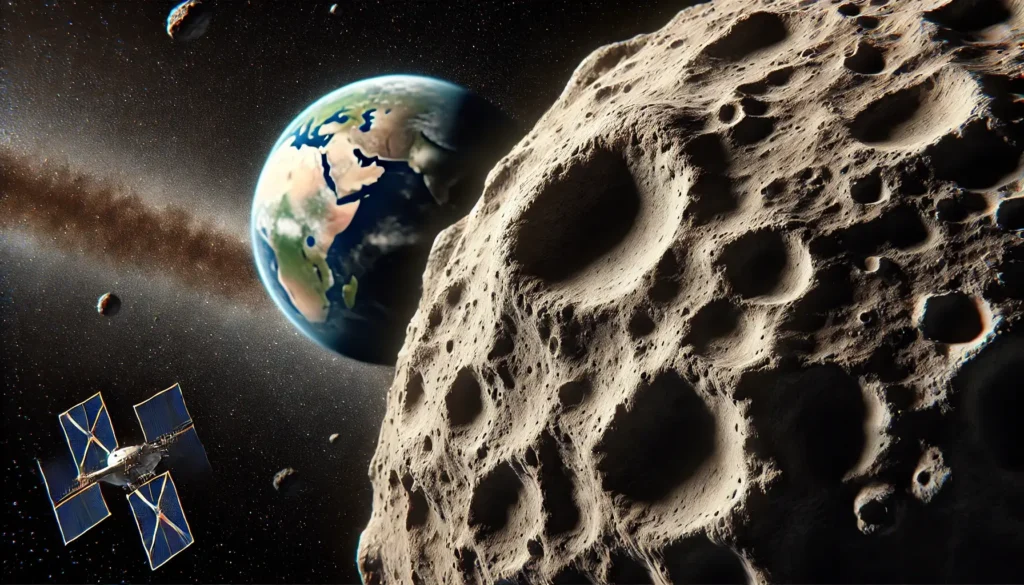Em 2029, o asteroide Apophis, também conhecido como o “Deus do Caos”, fará uma passagem tão próxima da Terra que poderá gerar tremores em nosso campo gravitacional. Mas, apesar da proximidade impressionante, não há risco de colisão. Essa passagem oferece aos cientistas uma oportunidade única para observar o asteroide de perto e estudar sua composição e trajetória.
Neste artigo, vamos explorar o que é Apophis, o que sua passagem de 2029 significa para a ciência e como os pesquisadores estão se preparando para o evento.
O que é Apophis “Deus do caos”?

Apophis é um asteroide com cerca de 370 metros de diâmetro, descoberto em 2004 pelos astrônomos do Observatório Kitt Peak, no Arizona. Seu nome, inspirado na divindade egípcia associada ao caos e destruição, reflete o impacto que sua trajetória inicial causou na comunidade científica, com especulações sobre o risco de uma colisão com a Terra. Embora a probabilidade de impacto tenha sido descartada, Apophis continua sendo um dos asteroides mais observados pelos cientistas devido ao seu tamanho e proximidade com o nosso planeta.
A Passagem de 2029
O asteroide Apophis passará a apenas 31.000 quilômetros da Terra em 2029. Para dar uma ideia, essa distância é mais próxima do que a órbita de alguns satélites de comunicação. Embora o risco de colisão tenha sido afastado, o que torna esse evento especialmente interessante é o fenômeno do impacto gravitacional. Esse evento pode causar pequenas alterações na órbita do asteroide, criando tremores no campo gravitacional da Terra.
O Impacto Gravitacional: Tremores no Campo Gravitacional da Terra
Quando um asteroide se aproxima tanto de um planeta, as forças gravitacionais podem afetar tanto o asteroide quanto o próprio planeta. No caso de Apophis, cientistas estão observando como o campo gravitacional da Terra pode interagir com o asteroide, criando o que são chamados de “tremores gravitacionais”. Embora não sejam “tremores” no sentido convencional (como os causados por terremotos), essas flutuações podem fornecer dados valiosos sobre a composição e estrutura interna de Apophis, além de auxiliar na compreensão das interações gravitacionais entre asteroides e planetas.
A Observação Científica de Apophis
A proximidade de Apophis em 2029 será uma oportunidade única para os astrônomos observarem o asteroide com mais detalhes. A NASA e outras agências espaciais planejam usar telescópios e sondas espaciais para estudar sua superfície, composição e comportamento. Técnicas de radar, por exemplo, permitirão mapear a estrutura do asteroide e determinar a densidade e a composição do material que o compõe. Esses dados serão cruciais para entender a formação e a evolução de asteroides, além de contribuir para os estudos sobre a defesa planetária.
Como os Cientistas se Preparam para o Evento
A preparação para a passagem de Apophis inclui o monitoramento contínuo da sua trajetória. A NASA, junto com outras agências espaciais internacionais, está atenta a qualquer alteração em sua órbita que possa representar algum risco para a Terra, mesmo que remota. Além disso, os cientistas estão utilizando supercomputadores para simular diversos cenários de aproximação, garantindo que o evento de 2029 não seja uma surpresa.
O Papel da NASA na Defesa Planetária
Embora o risco de impacto de Apophis seja mínimo, esse evento destaca a importância da defesa planetária. A NASA e outras organizações estão investindo cada vez mais no monitoramento de asteroides e na pesquisa de técnicas para desviar objetos que possam representar um perigo para o nosso planeta. O desenvolvimento de tecnologias para detectar e desviar asteroides, como o sistema DART (Double Asteroid Redirection Test), é um passo importante para proteger a Terra de possíveis ameaças futuras.
Impactos de Asteroides na Terra
A história da Terra já foi marcada por impactos significativos de asteroides. O evento que levou à extinção dos dinossauros é apenas um exemplo de como esses corpos celestes podem afetar a vida no planeta. Com o avanço da tecnologia e o aumento da conscientização sobre o risco de colisões, as estratégias para proteger a Terra estão evoluindo rapidamente.
Em fim
Apophis, o “Deus do Caos”, continua a fascinar cientistas e astrônomos em todo o mundo, especialmente com sua passagem próxima em 2029. Embora o risco de colisão tenha sido descartado, o evento oferece uma oportunidade única de estudo científico. A observação de Apophis poderá trazer avanços significativos no entendimento dos asteroides e na preparação para futuras ameaças do espaço.








Deixe uma resposta
Ver comentários